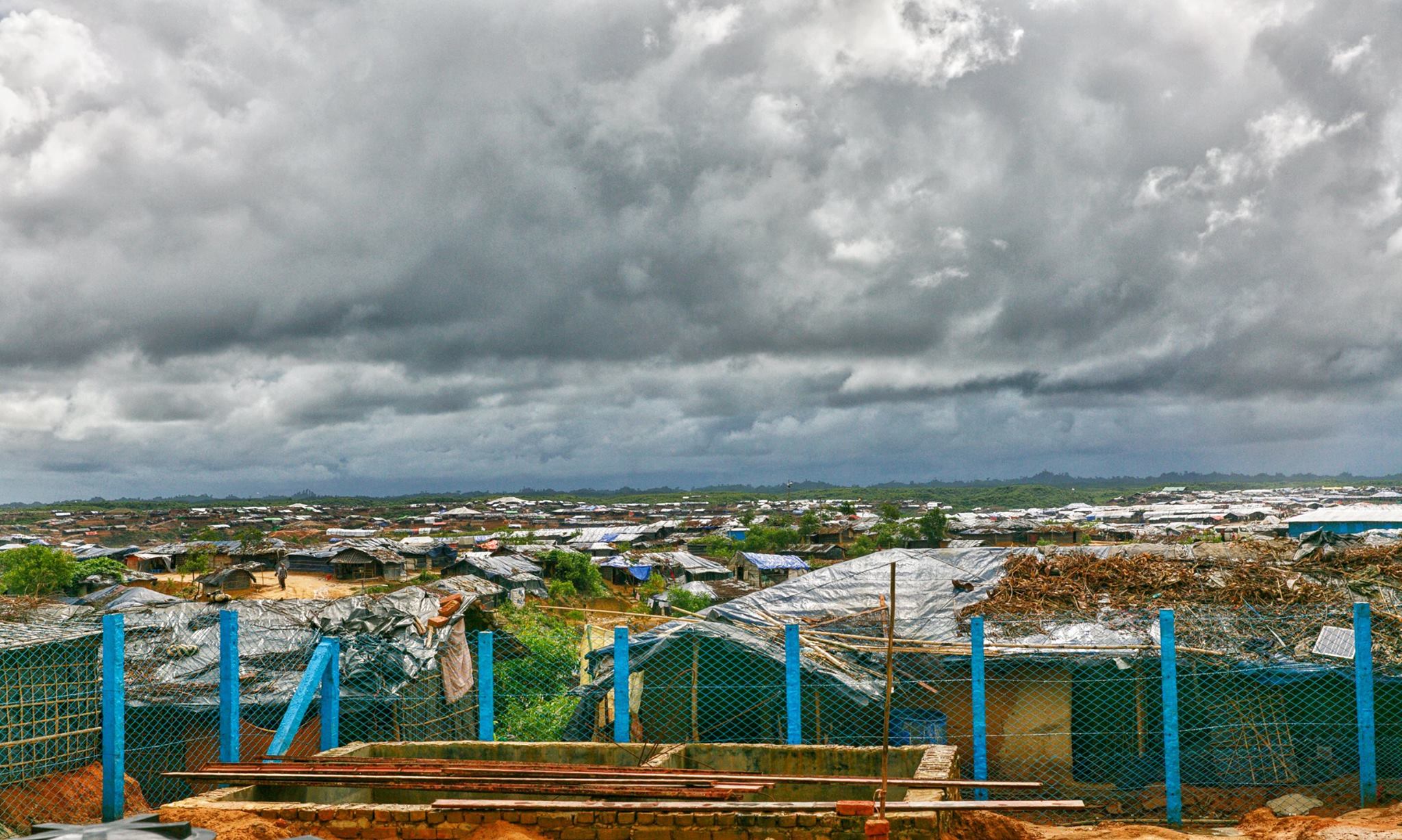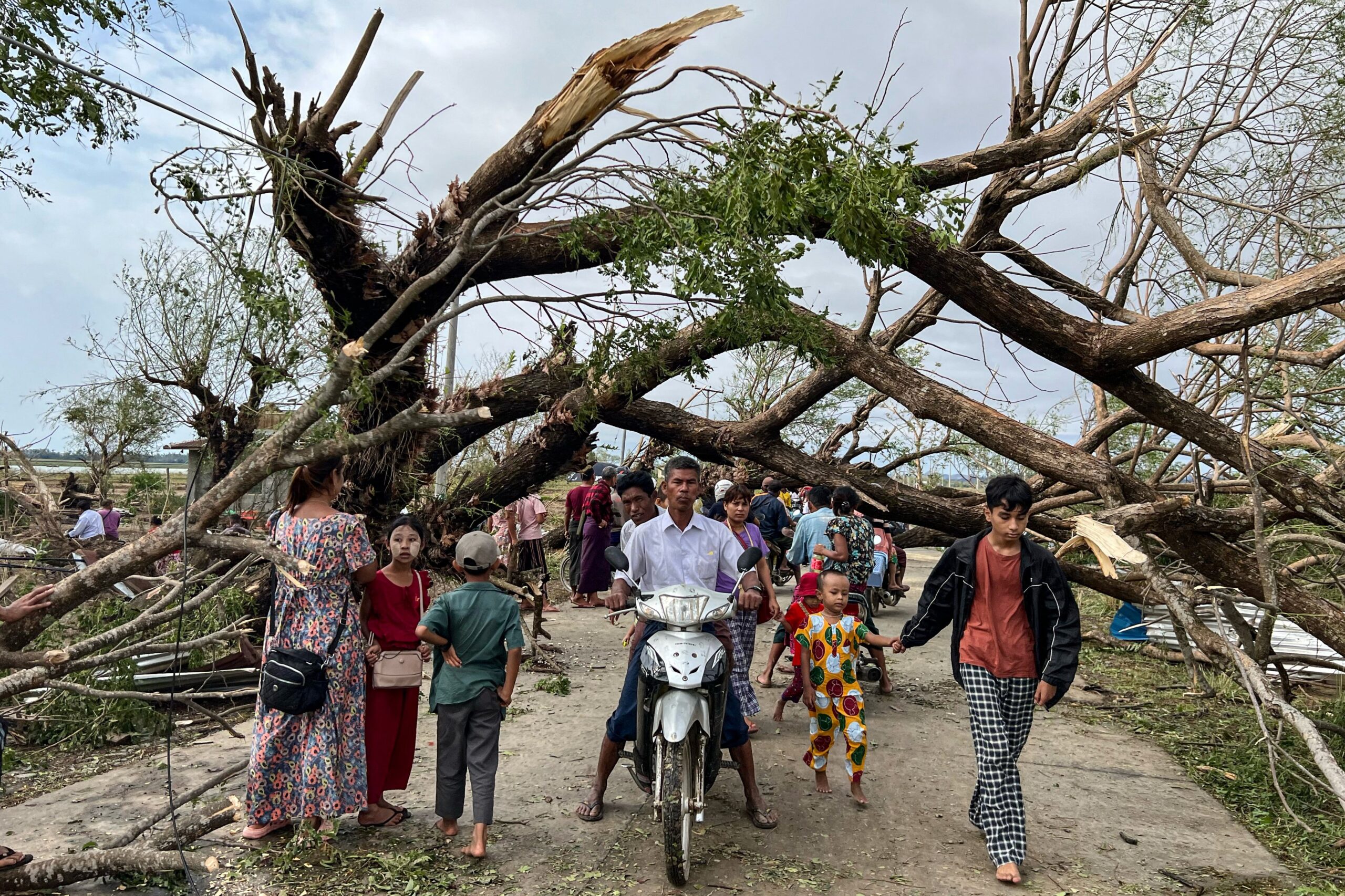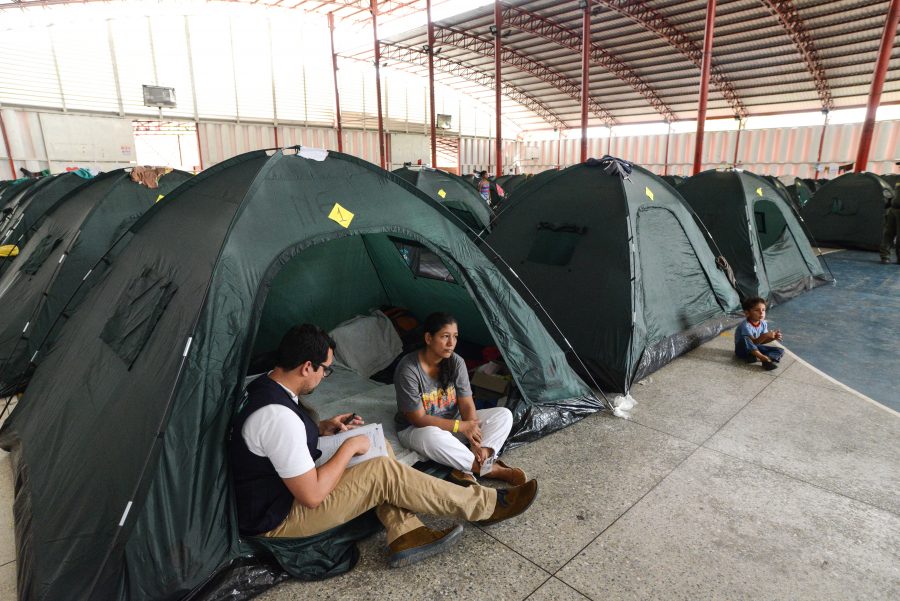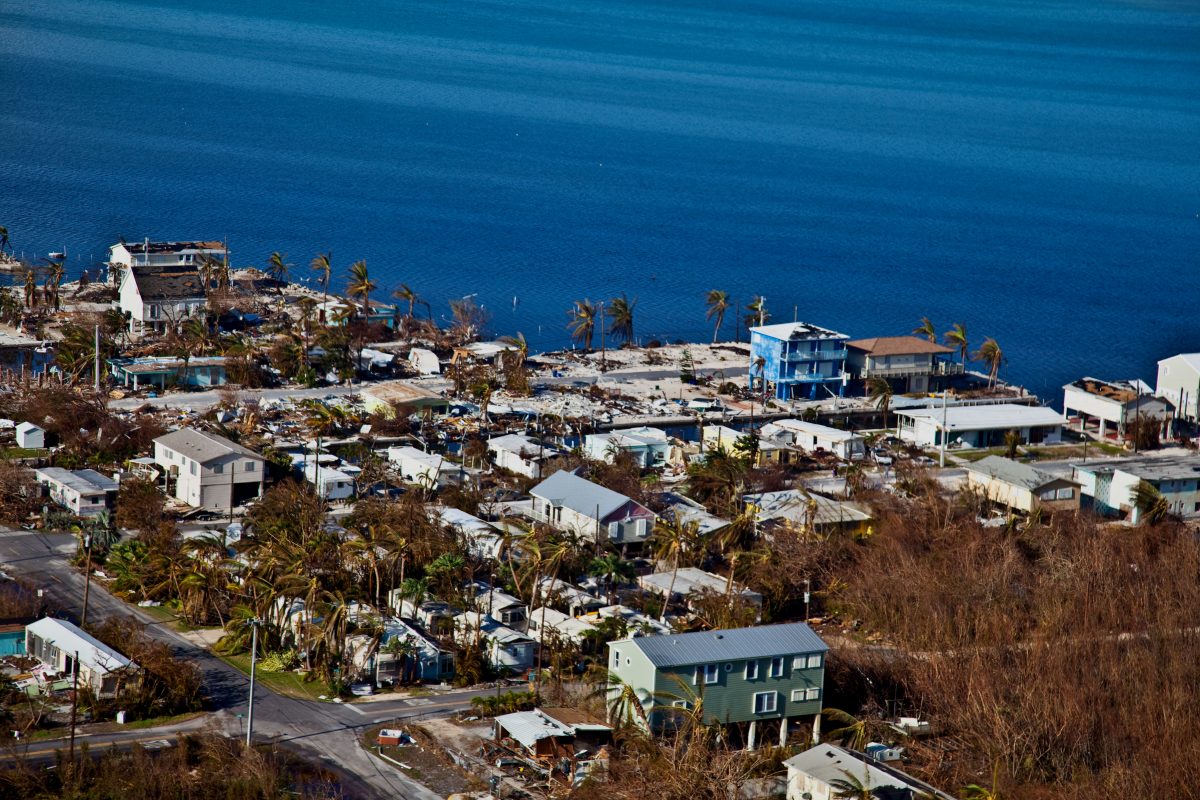

Extremely severe Cyclone Mocha made landfall on May 14, 2023 between Myanmar’s Kyaukpyu township and Cox’s Bazar, Bangladesh, with wind gusts over 134 miles per hour, equivalent to a Category 4 hurricane in the Atlantic.
Mocha was one of the strongest storms ever recorded in Myanmar. Storm surge was estimated at 9-11 feet, and low-lying areas in Myanmar’s Rakhine State and the neighboring southeast Bangladesh coast were inundated. Myanmar received the brunt of the storm’s impact.
The multisectoral Flash Appeal for Myanmar said heavy rainfall, storm surge and strong winds caused widespread damage across five states and regions – Rakhine, Chin, Sagaing, Magway and Kachin. Almost all buildings in Rakhine State’s Sittwe and Rathedaung suffered damage, and there was significant damage to public infrastructure in affected areas.
All cyclone-affected areas in Myanmar were already identified as having severe humanitarian needs, and the disaster will deepen those needs for hundreds of thousands. Myanmar is experiencing a complex humanitarian emergency due to ongoing fighting between Myanmar’s military and resistance militias and ethnic armed groups.
(Photo: The aftermath of Cyclone Mocha in Bangladesh, May 16, 2023. Source: U.S. Embassy in Dhaka via Twitter)
Each year, between June and October, communities across Myanmar’s Rakhine State experience heavy rains during the monsoon season. High levels of disaster risk combined with the socioeconomic vulnerability of millions, including displaced people, could result in new disasters and increase hardship for people affected by Cyclone Mocha.
Preparedness efforts in advance of the cyclone’s landfall were critical to limiting the loss of life, particularly in Bangladesh. In Cox’s Bazar, humanitarian agencies and residents worked to strengthen camp infrastructure, communicate about the impending storm, and pre-position staff and supplies. Tens of thousands of people were evacuated from low-lying areas in both countries. Bangladesh is a leader in effective, community-based disaster preparedness.
Latest Updates

What we’re watching: Weekly disaster update, May 22

What we’re watching: Weekly disaster update, May 15
Key facts
- Myanmar’s military junta has said the cyclone resulted in the deaths of at least 145 people, including 117 from the Rohingya minority. However, this figure is feared to be much higher. The Arakan Rohingya National Alliance, a human rights coalition, said more than 400 people were killed. There were no reports of casualties in Bangladesh.
- An estimated 7.9 million people in Myanmar live in areas that experienced strong winds and of these, 3.4 million faced destructive winds of more than 74 miles per hour, placing them at high risk considering pre-existing vulnerabilities.
- According to the World Bank, the median estimate of total direct damages caused by Cyclone Mocha is $2.24 billion, equivalent to 3.4% of Myanmar’s GDP in 2021.
- In Myanmar, more than 158,000 shelters were reportedly damaged or destroyed across affected states and regions.
- Sixty-two schools in Rathedaung township in Myanmar’s Rakhine State were destroyed or damaged during Cyclone Mocha.
- Rapid analysis of Cyclone Mocha’s worst-hit areas in Myanmar found that 60% of the landmine incidents reported in the first quarter of 2023 were in areas that have now been affected by the cyclone.
- In Cox’s Bazar, Bangladesh, reports suggested that shelters, water points, latrines, culverts, bridges and other key community infrastructure were damaged. Bangladesh has not seen the same level of destruction as Myanmar.
Complex humanitarian emergency worsened
Myanmar’s complex humanitarian emergency (CHE) was already categorized as a Level 1 CHE by CDP before Cyclone Mocha. Disasters often exacerbate pre-existing inequities and vulnerabilities within communities, and this occurred in Myanmar.
Ramanathan Balakrishnan, the UN Resident Coordinator and Humanitarian Coordinator for Myanmar, said following the disaster: “It really is a nightmare scenario for this cyclone to hit areas with such deep pre-existing needs.”
Human Rights Watch said in the aftermath: “the resulting living conditions are, by design, squalid, contributing to a growing tally of preventable deaths and annual threats from extreme weather.”
According to ACLED’s Conflict Severity Index, in 2022, Myanmar experienced the third most intense level of violence after Ukraine and Syria. The country’s conflict is complex and involves hundreds of non-state armed groups fighting against the military junta and joining other ethnic-based rebel organizations that have been active for decades.
In the two years since Myanmar’s military seized power, declaring fraud in the general election won by the National League for Democracy, the fighting has significantly increased humanitarian needs and attacks on civilians persisted following the disaster.
An Assistance Association for Political Prisoners report said Myanmar’s military killed 157 children in 2022. An April 11, 2023 attack by Myanmar’s junta military on a village celebration in the central Sagaing region left at least 186 villagers dead, including children. Records documenting the deaths and injuries from the attack that were provided exclusively to The Washington Post by a network of local medics show that at least 25 children were among the dead. The Network for Human Rights Documentation-Burma documented 13 civilian deaths due to the military’s artillery attacks and 70 civilian arrests within the week of Sept. 8-14, 2023 alone.
According to Myanmar’s 2023 HRP, which lays out the shared vision of how to respond to the assessed and expressed needs of the affected population, one in three, or 17.6 million people, are in humanitarian need, an increase of one million people since the start of 2021. The Rohingya people, a stateless ethnic group, have faced decades of systematic discrimination, statelessness and targeted violence in Myanmar’s Rakhine State. Violent attacks led hundreds of thousands of Rohingya to flee to Cox’s Bazar, Bangladesh, in 2017. Hundreds have fled by boat from desperate conditions in Myanmar and camps in Bangladesh. In late March 2023, more than 180 Rohingya Muslims landed in Indonesia’s Aceh province. The year 2022 was the deadliest for Rohingya at sea for years.
Food insecurity
The ongoing conflict has led to food shocks and decreased agricultural production, subsequently affecting livelihoods and overall food security. A report published by FAO and the World Food Programme (WFP) included Myanmar in a list of 18 “hunger hotspots” where critical food insecurity is projected to intensify. In 2022, Myanmar was one of the three largest food crises in the world, according to the Food Security Information Network, and the cyclone has exacerbated the situation.
The Myanmar Flash Appeal said, “Cyclone Mocha has structurally undermined food security by inducing losses of existing food stocks, agriculture inputs and assets for implementing income-generating activities (e.g., fishing material, small businesses), as well as reducing access to markets and increasing food prices.”
In Myanmar’s Northwest, the agriculture and fishery sectors were badly hit, with the cyclone causing loss of assets crucial for livelihoods and “posing a longer-term threat to food security.”
The agricultural and fishery sectors in Rakhine State and the Northwest have suffered enormous losses, with more than half of production capability lost in Sittwe, impacting essential assets for livelihoods.
In their July 15 Myanmar Humanitarian Update, UNOCHA reported, “Income losses, coupled with high inflation, have worsened food insecurity. Among households that have experienced significant income reductions, the level of food insecurity is particularly severe.”
According to the Food and Agriculture Organization of the UN (FAO), “The current food insecurity situation is critical due to reduced agricultural production in 2022, intensified conflict, record high food prices and the devastating effects of Cyclone Mocha.”
Shelter
Extensive damage was reported in IDP camps in Myanmar’s Rakhine State. For example, in Kyauktaw IDP camps, some volunteers reported that nearly all the bamboo IDP shelters and tarpaulins were destroyed. Field observations in the Sittwe camps revealed most of the shelters were heavily damaged.
In Rakhine State, more than 200 pre-existing displacement sites were severely damaged, and shelter debris posed additional risks to the IDPs. In Kachin alone, cluster partners identified that more than 15,500 IDPs in Shwegu, Mohnyin, Hpakant and Waingmaw townships needed shelter and non-food items assistance.
The World Bank’s Global Rapid Post-Disaster Damage Estimation (GRADE) report found the median estimate of total direct damages caused by Cyclone Mocha is $2.24 billion, equivalent to 3.4% of Myanmar’s GDP in 2021. Damages to housing and non-residential buildings account for over 49% and 18% of the total, respectively. The GRADE report said that in Rakhine State alone, more than 200,000 buildings were damaged or destroyed. The hardest-hit townships were Sittwe and Rathedaung.
In Cox’s Bazar, Bangladesh, approximately 930,000 Rohingya refugees resided in thirty-three camps. Refugees’ shelters are largely constructed from bamboo poles and tarpaulins, making them highly vulnerable to the impacts of cyclones, flooding and landslides. Women, children, the elderly and people with disabilities were among the most vulnerable.
In the International Organization for Migration’s (IOM) area of responsibility, 5,155 shelters were moderately or severely damaged across all three camps, of which 144 of those assessed were fully damaged. Rohingya Refugee Response, which coordinates humanitarian support for refugees in Bangladesh, said 5,800 shelters were damaged and 400 destroyed.
Food security and livelihoods
According to the Myanmar Flash Appeal, “The impact of Cyclone Mocha will deprive more children and pregnant and lactating women of access to timely and lifesaving nutrition treatment and support, contributing to increased morbidity and mortality.”
Targeted food and nutrition assistance to vulnerable populations will remain an ongoing recovery need. Households completely lost their seed stocks. In Rakhine State and the northwest, the agriculture and fishery sectors were badly affected, leading to losses of assets essential for livelihoods. Therefore, livelihood support, particularly in rural areas, is needed.
Health
The health needs in Myanmar have continued to expand and intensify since the 2021 coup. Among the most vulnerable are IDPs and stateless people who are most likely to lack physical access to healthcare and the economic means to pay for it.
UNOCHA reported that health partners said several hospitals were damaged in Rakhine State. With many health facilities affected by the cyclone, people who sustained injuries and need ongoing medical care, such as rehabilitation, will likely have a harder time finding it.
In addition to the physical damage and needs, mental health and psychosocial support are needed for a population affected by years of conflict, displacement and natural hazards. Support for mental health professionals is an important ongoing need during recovery.
In-kind and cash assistance
The Center for Disaster Philanthropy (CDP) recommends cash both as a donation method and a recovery strategy. Providing direct cash assistance can allow families to purchase items and services that address their multiple needs. It gives each family flexibility and choice, ensuring that support is relevant and timely.
Cash-based approaches to disaster recovery also give people the freedom to choose how they rebuild their lives and provide a pathway to economic empowerment. However, depending on the context, in-kind donations may be needed and appropriate. A critical factor in ensuring cash assistance is effective is functioning markets.
Protection
After a disaster, protecting vulnerable individuals and ensuring access to their basic rights are ongoing priorities. This is particularly important in the context of the current complex humanitarian crisis and the attacks on the Rohingya and civilian populations by Myanmar’s military.
Myanmar is believed to be one of the most mine-contaminated countries in the world. According to the Myanmar Flash Appeal, “More than 60 per cent of the landmine incidents reported in the first quarter of 2023 are from areas recently affected by Cyclone Mocha and 90 per cent of the incidents reported were in red zones, where wind speeds of over 120 km/h were recorded.”
Shelter
The affected areas are populated by IDPs and refugees who were already living in precarious situations. Support for and shelter materials for repairs and rebuilding will remain an ongoing need.
As of September 2023, shelter assistance remains a primary concern in Rakhine State, with more than 72,000 Rohingya and Kaman IDPs in camps being in need of shelter reconstruction and thousands more Rohingya, Rakhine and Kaman IDPs living in makeshift shelters in need of shelter assistance.
Water, sanitation and hygiene (WASH)
In Rakhine, cluster analysis from May 2023 found that 58% of 196 displacement sites lacked sufficient water, 57% were without appropriate sanitation and 72% experienced hygiene gaps at that time. More than 22,000 latrines were damaged in 646 sites, and 86% of affected populations lacked appropriate hygiene supplies. Restoring access to safe water and sanitation is an ongoing need.
As Myanmar experiences rainy seasons, vector control agents and mosquito nets will continue to be needed in displacement sites and for communities across Rakhine State as diseases such as dengue become more prevalent after the disaster.

Our Global Recovery Fund provides support for cyclone-affected communities. Grants will be focused on supporting marginalized communities in the recovery phase.
Contact CDP
Philanthropic contributions
If you have questions about donating to the CDP Global Recovery Fund, need help with your disaster-giving strategy or want to share how you’re responding to this disaster, please contact development.
(Photo: Damage in Myanmar following Cyclone Mocha, May 15, 2023. Source: USAID via Twitter)
Recovery updates
If you are a responding NGO, please send updates on how you are working on recovery from this disaster to Tanya Gulliver-Garcia.
We welcome the republication of our content. Please credit the Center for Disaster Philanthropy.
Philanthropic and government support
CDP has previously supported recovery in Myanmar. For example, CDP awarded $200,000 through its COVID-19 Response Fund to Asia Foundation to create new economic opportunities for vulnerable under/unemployed job-seeking youth and help small and medium businesses maintain business continuity and survive during COVID-19 as well as adapt for a post–COVID world.
The Myanmar Cyclone Mocha Flash Appeal was announced by humanitarian partners on May 23, 2023, and requested $333 million to provide humanitarian assistance to 1.6 million people.
The combined $886.7 million Humanitarian Response Plan and Cyclone Mocha Flash Appeals were critically underfunded as of Oct. 2, with donors providing only 28% of the required funding.
Donor governments around the world provided support for humanitarian assistance, including Thailand, the United Kingdom and the U.S.
Thailand and Myanmar share a nearly 1,500-mile border. Tens of thousands of refugees from Myanmar are in Thailand, although Thailand is not party to the 1951 Refugee Convention. The U.S. government officially uses Burma in reference to the country of Myanmar.
More ways to help
CDP has also created a list of suggestions for foundations to consider related to disaster giving. These include:
- Prioritize investments in local organizations: Local humanitarian leaders and organizations play a vital role in providing immediate relief and setting the course for long-term equitable recovery in communities after a disaster or crisis. However, these leaders and organizations are mostly under-resourced and underfunded. Grant to locally-led entities as much as possible. When granting to trusted international partners with deep roots in targeted countries, more consideration should be given to those that empower local and national stakeholders.
- Take the long view: Recovery will take a long time and while recovery efforts can begin immediately, funding will be needed throughout.
- All funders are disaster philanthropists: Even if your organization does not work in a particular geographic area or fund immediate relief efforts, you can look for ways to tie disaster funding into your existing mission to support long-term recovery. If you focus on education, health, children or vulnerable populations, disasters present prime opportunities for funding these target populations or thematic areas.
- Ask the experts: If you are considering supporting an organization that is positioned to work in an affected area, do some research. CDP and InterAction can provide resources and guidance about organizations working in affected communities.
Resources

Complex Humanitarian Emergencies
CHEs involve an acute emergency layered over ongoing instability. Multiple scenarios can cause CHEs, like the civil wars in Syria and Yemen, the man-made political crisis in Venezuela, or the conflict in Ukraine.

Hurricanes, Typhoons and Cyclones
Hurricanes, also called typhoons or cyclones, bring a triple threat: high winds, floods and possible tornadoes. But there’s another “triple” in play: they’re getting stronger, affecting larger stretches of coastline and more Americans are moving into hurricane-prone areas.

Disaster Phases
Disasters affect millions of people and cause billions of dollars in damage globally each year. To help understand and manage disasters, practitioners, academics and government agencies frame disasters in phases.